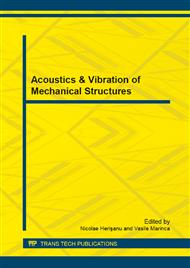p.3
p.14
p.22
p.27
p.32
p.40
p.45
p.53
p.63
Physical Instability and Functional Uncertainties of the Dynamic Systems in Resonance
Abstract:
Depending on the type of systems, the resonance states are either short and without inducing structural changes, or lead to forced variations of the elasticity and damping parameters with the additional energy absorption. For the material physical systems, that simulate the dynamic behavior of equipments, industrial plants and constructions, the operation in resonance mode is unstable being characterized by pulse variations in the band-pass. In this case, the necessary energy input, from outside, when the operation state is maintained within the band-pass, inevitably leads to the modification of the elastic and damping parameters and to structural degradation processes appearance. Thus the resonance band, Δω, considered as a significant parameter of the excitation, as well as the specific relaxation duration considered as an intrinsic system parameter are in a functional correlation of the dynamic system. When the dissipation increases Δc > 0, the relaxation duration drops with Δt=m/Δc, in such a way that the relation Δω Δt = 1 is valid, similar to the Heisenberg indeterminacy formula for subatomic particles. It can be observed that for Δt tending to 0 and for very high values of Δc the resonance state can be achieved for any value of the excitation pulsation as a discrete variable parameter by the modification of the viscous component. In the ideal case, the resonance interval is reduced to a single value that corresponds to its own pulsation. The systems dynamic behavior generated by periodic functions resulting in either forced vibrations or wave propagation processes in viscoelastic media is characterized by doubtful operation and physical instability within resonance.
Info:
Periodical:
Pages:
32-39
Citation:
Online since:
September 2013
Authors:
Keywords:
Price:
Сopyright:
© 2013 Trans Tech Publications Ltd. All Rights Reserved
Share:
Citation:


